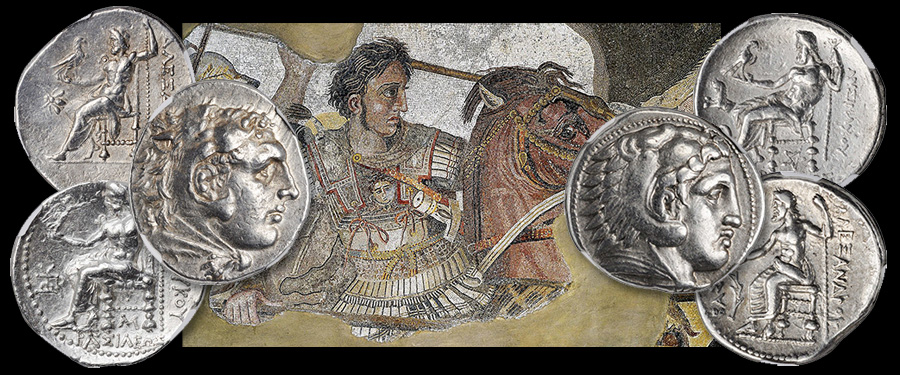Outside of an Athenian “owl,” there may be no more desired—and iconic—coinage from antiquity than that featuring one of the most successful military commanders in history, Alexander III of Macedon—often known simply as Alexander the Great. Born in 356 B.C. to Philip II, king of Macedon, at age 20 Alexander would inherit his father’s realm and stature within the Hellenic world following the assassination of Philip by his personal bodyguard in 336 B.C. Despite his relative youth, he was ready to take the reigns of power, having been well trained and tutored as a boy by the famous Greek philosopher, Aristotle. Philip’s well-trained army was a vital component to Alexander’s grand plans, as the new king sought to achieve what his father had sought—a Greek conquest of Persia. Just five years later, the mighty Darios III and his Achaemenid Empire—stretching from North Africa to what is the modern-day western border of India—was defeated. During the next five years, Alexander continued to expand his empire, until it essentially comprised much of what was known in that part of the world at the time. He led further invasions into India, thought he was turned back to the Near East due to troop fatigue and homesickness. While in Babylon, Alexander succumbed to an uncertain malady in 323 B.C., the source of which has been cause for speculation during the two millennia since. With that untimely event, the vast realm of Alexander—just under the age of 33 at the time of his death—was forever broken.
Despite reigning for only 13 years, Alexander had a vast output of coinage struck bearing his name (ΑΛΕΞΑΝΔΡΟΥ= ‘of Alexander’) and its rather consistent iconography, ensured its widespread recognition. Most well known among collectors now are his silver denominations, such as the drachm and its multiple, the tetradrachm. These coins featured the bust of Herakles on their obverse, with a seated Zeus on their reverse. The reverse was also utilized for the placement of various control marks and symbols alluding to a place of manufacture, local authority, date, etc. With the knowledge to decipher the various markings, one can attribute an issue to a particular city and time period, sometimes even a specific year. Following the pivotal and consequential event of Alexander’s death, some of his powerful and influential generals, such as Seleukos, Ptolemy, Lysimachos, and Kassander, carved up his former empire, with some establishing rather lengthy dynasties in their name. What did not immediately change in many instances was the look of the coinage struck under the new authorities. Owing to the lofty status that Alexander held in death and the recognizable features of his coinage throughout the region, the Herakles head/seated Zeus style was continued, sometimes even retaining Alexander’s name even after his death. Modern scholarship, through such things as hoard studies, has shed further light onto a chronology of these issues, allowing this vast output of ‘Alexander-style’ coinage to be classified and dissected—perfect for any collector looking to embark upon a rich series that has much to offer.
Our June Collectors Choice Online (CCO) sale will feature a number of these silver issues of Alexander the Great himself, as well as many from his generals (Seleukos, Ptolemy, and Lysimachos) and his elder half-brother (Philip III, who succeeded him in Macedon merely in name). Also represented is a civic issue from Miletos, struck in the early-mid 3rd century B.C., and an issue from Attalos I, the king of Pergamon, issued over a century after Alexander’s death. Both of these coins are a testament to the important role that the ‘Alexander-style’ coinage played in regional commerce, as it served, for quite some time, as the de facto coin of the realm. Give a closer look to all of the issues and you’ll start to discover the subtle differences in not just symbols, but also in engraving style, allowing for a wonderful area to study and pursue.
To view our upcoming auction schedule and future offerings, please visit StacksBowers.com where you may register and participate in this and other forthcoming sales.
We are always seeking coins, medals, and pieces of paper money for our future sales, and are currently accepting submissions for our October Hong Kong Auction (until July 29) and our January 2021 Official Auction of the N.Y.I.N.C. Our next CCO (Collectors Choice Online) auction will be in June, with another following in October (for which the consignment deadline is September 8). If you would like to learn more about consigning, whether a singular item or an entire collection, please contact one of our consignment directors today and we will assist you in achieving the best possible return on your material.






